Know the uniqueness of the Japanese garden - his philosophy, species, color, the main components and plants suitable for the middle strip of Russia.
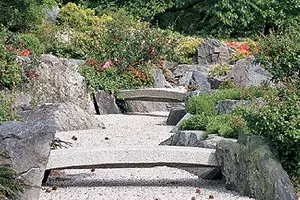
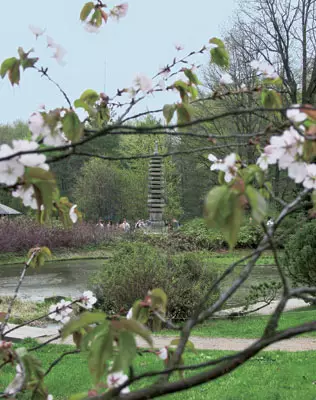
Japanese muddy blooming sakura, cleanliness symbol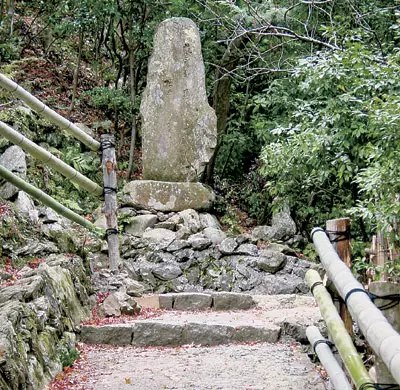
Kkcamny in Japan are treated as living beings. According to the religious teaching of Coto, spirits inhabit them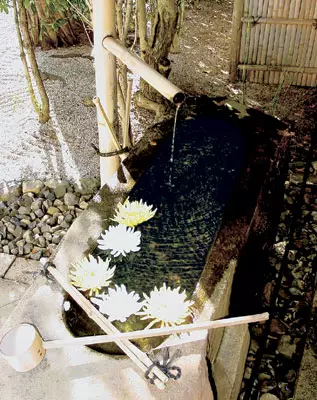
Tsukbay is usually located near a tea house. From here taking water for making tea and ablution of hands in front of the tea party ceremony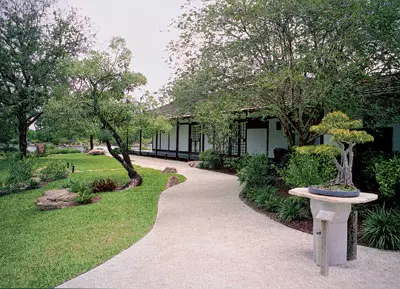
The Vyagno Garden is often set bonsay plants in plasters. At the time of the holiday or to the arrival of guests they are entered into the house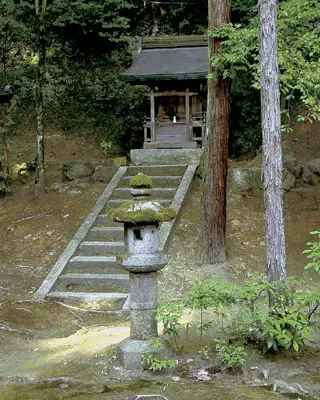
Garden of the Temple of Reanzy (Japan) - the kingdom of green plants and moss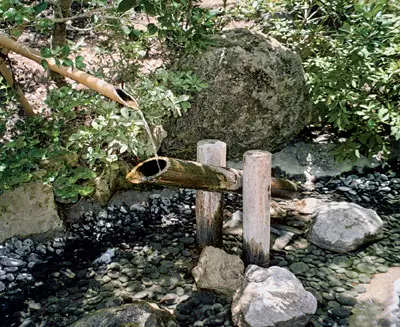
Soto is intended to scare away wild animals from peasant gardens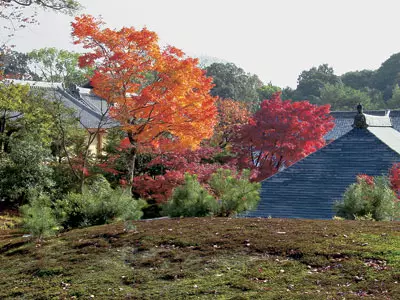
In the autumn bright colors weave Japanese maples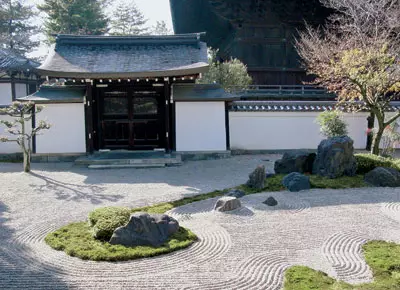
"Dry" landscape in the garden of Tokufuji Temple (Kyoto, Japan). Pebbles symbolically depicts water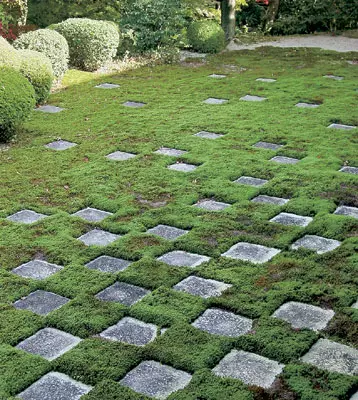
Squares from moss and stone are combined according to the free laws of asymmetry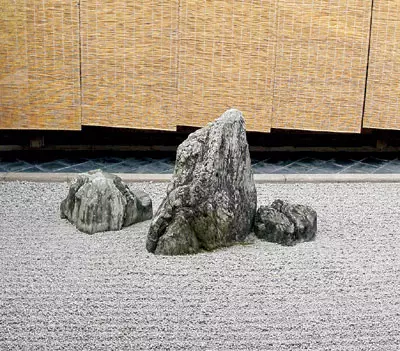
Composition of stones in the garden Daizenin (Japan)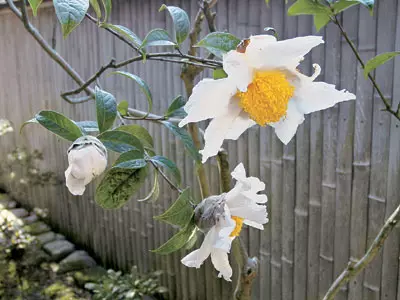
Camellia Flowers Japanese are very large, with a lot of stamens. From the leaves of this shrub in the east, oil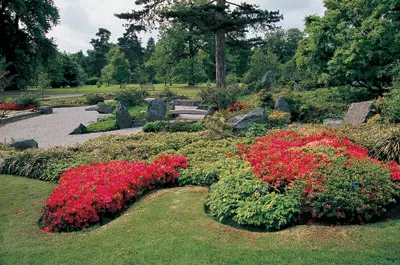
Japanese garden in Kew (United Kingdom)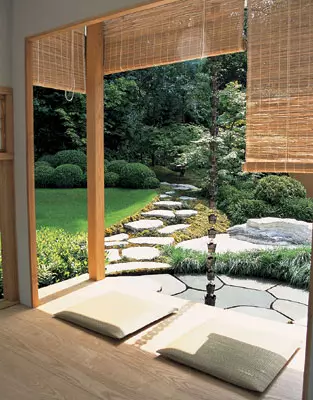
The Garden The Gapanese Way, the exhibition in Chelsea (United Kingdom). When you change the height of the blinds, the landscapes visible from the house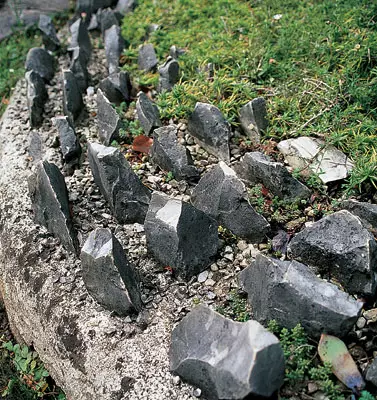
Stones in miniatures symbolize rocky mountains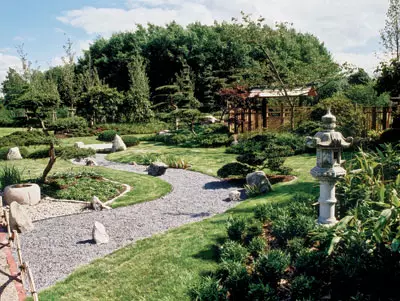
In the "Park Gardens" in the suburb of Hamburg (Germany)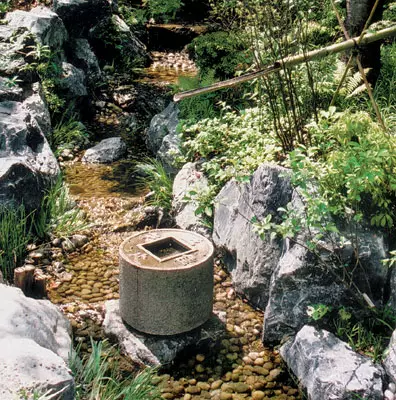
Tsukubai in the Japanese garden on the Dutch Floriad
At nature can be comprehended by contemplation and intuition, the Japanese consider. To come to the garden, listen to the singing of birds, splashing frogs, admire the flowers and droplets of dew, flickering on the edges and shaggy caterpillars ... Learn nature means learning the world and yourself. Japanese gardens are unique and very attractive. But, it seems, their mystery is still not solved by Europeans to the end ...
Philosophy of Garden
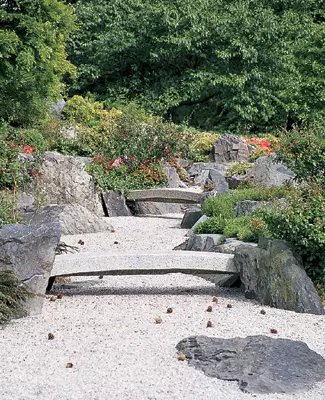
Bridges over the "dry" river "Japanese Garden" - a concept, familiar to people in many countries of the world. But describe what he represents is, not so simple. First, the Japanese garden is characterized by a certain set of elements: stones, water, a large number of evergreen plants, as well as lights and bamboo hedges. The color gamut of the Japanese garden is very restrained and does not replete with motley paints. Secondly, the Japanese garden is always filled with a very deep sense, behind the outer shell of each element hides a secret meaning, "a miracle of things." Such an attitude to nature was laid by the ancient religions of Japan, syntoism (teaching, where stones, mountains and trees are inhabited by the spirits of Kami) and Zen-Buddhism.
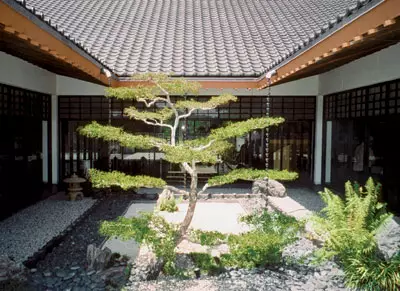
The garden in the inner courtyard is like another, the living room in the domain contacts believe that nature can be comprehended only by intuition, but not logical conclusions. Therefore, a person comes to a garden for contemplation, reflections, for penetration into the essence of things and knowledge of oneself. It does not look like European admissions by man-made landscapes.
Types of gardens
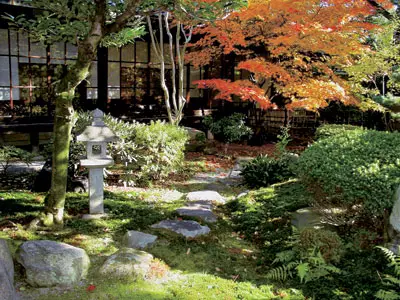
The house and the garden are harmoniously connected to each other - one is the continuation of the other. VVDA Chironin Temple (Japan) Japanese gardens are very different. If we talk about their purpose and sizes, you can highlight palace, temple, home gardens and tea ceremony gardens.
Palace Sad. Very ancient, worldly, secular and appearance closer to Chinese. Usually it occupies a large area, dissected by many tracks, for which you can walk by opening new and new types. It is allowed to have decorative elements, small pavilions are placed in secluded places.
Temple garden Created more for contemplation, rather than to enjoy walks. Stone Pagoda may be located (the symbolic image of one of the elements of the Buddhist temple complex).
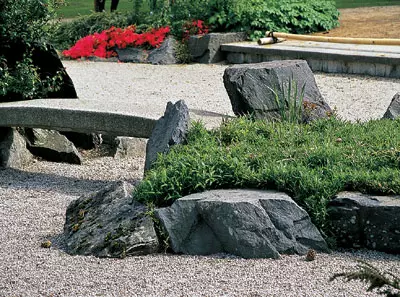
Stones are preferable to choose untreated, natural natural form Home gardens It is small (only from 3-4m2 to several tens of acres). These can be miniature copies of the landscape of Japanese islands or classic Chinese landscapes.
AVTO tea ceremony There is necessarily a tea house, near the stone bowl with water (Tsukbay) and a stone lamp. According to the nature of the relief and illumination, the gardens can be divided into hilly and flat. Depending on the dominant element, which determines the color and composition of all other parts, distinguish the gardens of moss, water, stones, ferns.
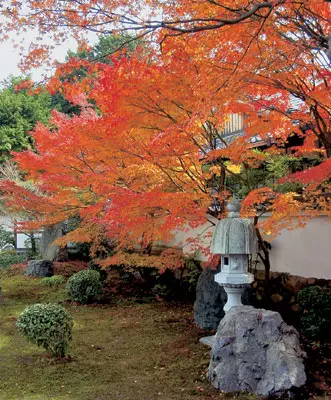
Japanese gardens still remain a mystery for the European consciousness. It concerns the general trend of the development of this pure Japanese art, then here, in the course of the centuries, there is a transition from simple imitation of natural landscapes to the "philosophical" gardens symbolic and even abstract. So, in symbolic A group of stones depicts a specific image (like, for example, a "resting bird with open wings" or "crossing a tiger with crucibles through a stormy stream" in the Romani Garden in Kyoto). Ichelovka, contemplating them, trying to see, intuitively sense this image. Great distribution was also "Dry" landscape where water is depicted symbolically, with the help of stones and pebbles. Babraction gardens There is no place for a similar game with images. The visitor becomes as if co-author of the Master and himself fills the garden with his ideas, surviving the same revelation, which artist felt.
Landscape elements
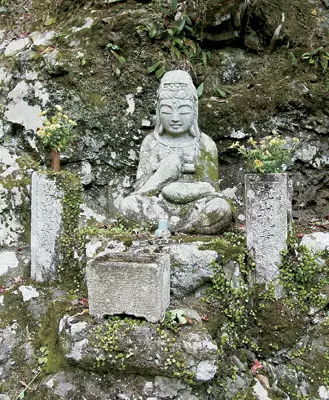
Buddha statue on the trail to the temple on Mount Arashka in the suburb of Kyoto (Japan) Nature gave a lot of materials to create gardens, very diverse in shape, color and texture. These are trees and stones, flowers and moss, sand and grass, pebbles and water. Stones and water are considered the main elements and are necessarily present in each Japanese garden. It is often repeated that the mountains are the "skeleton" of nature, its water "blood".
Stones for a long time used only untreated. Judge if they are processed, they still had to seem completely natural, natural. The ownership of the art of their alignment (SUTE-ICI) is the main thing for the artist Garden. Mounting stone has its own "posture", its "face", its own plastic, in shape they can be statues, low verticals, flat, lying or curved.
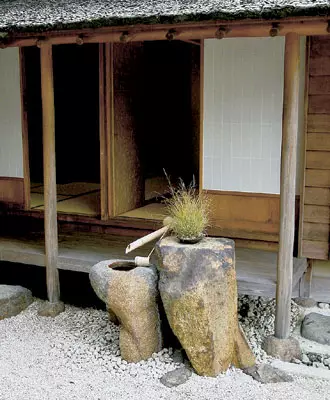
Stone and water - these two elements are present in any Japanese
Garden in the importance of the garden component. Without it there is no life, she gives coolness on a hot day, they will like plants, animals and man. Water is calm or stormy, rapid. Burdening streams and mountain rivers with their rustling, splash and rokat, is another, sound design of the garden. Near tea houses usually have zucubai-stone bowls, of which visitors are buried by bamboo brush water for the ablution of the hands and making tea. Instantyanic gardens can be found socially "water swings", designed to scare away wild animals, deer and boars. Water drops drops into the cavity of the swinging bamboo stem, open on one side. From the water, one part is heavy, and at some point the stem tipping over. Water poured sharply, "swings" return to its original position, hovering about the underlying stone at the bottom and rejects the wild animals.
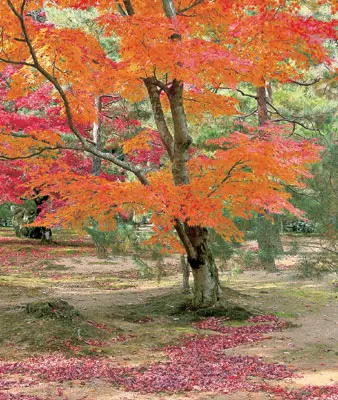
The alpony is popular two types of maples - Japanese and fan. The beautiful shape of the crown and sheet is distinguished, as well as the bright autumn-colored plant of plants, the Japanese are very carefully. Preference is given to evergreen trees and shrubs, because the garden is an image of paradise on Earth, and everything is constantly changing into paradise over time. One of the favorite plants is pine, a symbol of longevity and constancy. Bamboo symbolizes nobility, masculinity and durability, so bamboo groves are planted in many gardens. It also makes swelling and wickets. Of the flowering trees, Sakura and Sakura, from shrub, Camellia and Azalya, always used special honor. Blooming Sakura for Japanese peasants served as a signal to the beginning of the sowing rice, a sign confirming that the soil and water warmed enough. Usamuraev Sakura - a symbol of persistence and purity, because her petals never faded on the tree and fall "alive." From flowers in honor of orchid, irises, peonies, daffodils, poppies, chrysanthemums, basins, lotuses. But the best diversity and the sophisticated sophistication of nature are uncovered not bright colorful flowers, and the Japanese consider Mossa.
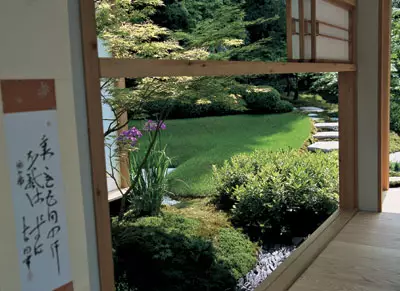
Lilac butterflies flute among the green kingdom flowers Irisovis of the man-made elements of the landscape are popular with lanterns (Toro) and pagoda, made, as a rule, from stone. The flashlight (in the modern version inside it is usually the shimmering light bulb) illuminates the path in the dark and directs attention to individual elements of the landscape. There are many varieties of lanterns, each of them has its origin and place in the garden. From architectural structures, except for the house, a gazebo or pavilion can be present in the garden, where we expect a tea ceremony, or a tea house.
Exotic in Russia
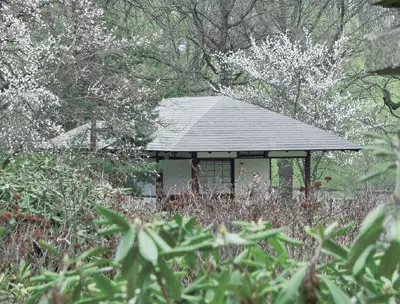
SPRING - the time of flowering Sakura and light fog haze over the fields of "Japanese" gardens created in Russia, copy the landscape art of Japan only externally, they are rarely filled with any symbolic content. Therefore, sometimes there are some incident like SOCA from the peasant garden next to Paroda, that is, the Buddhist temple. Truly exotic! How deeply should and borrow another culture of the rhetorical question. Everyone responds to it in its own way. But we would like you to carefully relate to the traditions of other countries.
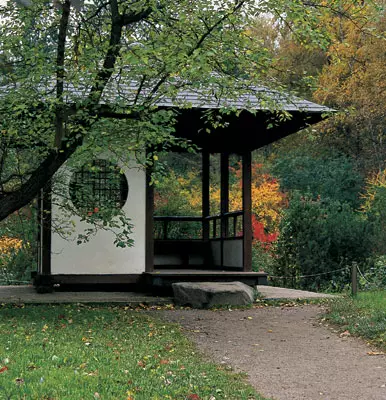
Japanese structures recognizable on round windows, the shape of the roofs and the overall ease of construction. When you decide to acquire a miniature copy of the Japanese landscape on your site, the first thing is the question of plants. On the Japanese islands, the climate is warm and wet, not at all such as, for example, in the middle lane of Russia. It means that for many plant species you need to select alternative options. The visual image of Sakura can be transferred with the help of Cherry's cherry, almonds of three-bladed, different drains, Manchur apricot. Japanese and fan, distinguished by an unusually beautiful form of crown and leaf, bright autumn coloring, are very popular from maples in Japan. But in the middle of Russia, they, unfortunately, are frozen. In the form of the crown and paints to the Japanese maples close to the Manchurian, and the leaf-maple of the Falseboldov. Also use maple Tatar and striped, their crown is easy to form.
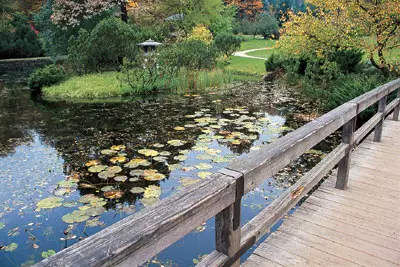
The Japanese garden in Moscow (GBSran) from coniferous rocks usually planted different shapes of pine mountains, cedar sluts, fir balsamic and various juniper. From the flowering shrubs, we plant Rhododendrons and Azaleas, be sure to cover them for the winter. Of all the irises, Iris Siberian is more suitable with narrow thin bluer characters characteristic of it, as if the butterfly soaring in the air, they hang flowers. Owls can land the Bolotnaya Iris. Mosses are transferred from nature or replace them with surcharges and encounters.
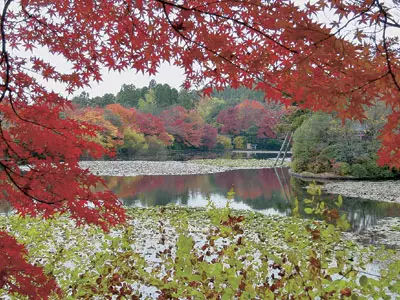
Changing the nature, you can learn yourself - the Japanese grades from cut dry bamboo (fences, wickets, decorative elements), built in the open air, are darken and lose their beauty after some time and lose their beauty. It is recommended to leave the gaps between the surface of the earth and the lower edge of such bamboo hedges. Forest sections need to be embedded, and the trunks themselves to process the protective composition. So that they do not crack, jumpers inside them are drilled. The Japanese corner can be surrounded by the hedges from the Tui, tees or bubbler, a kizilnik, high spirire, the pots.
Of the stones in Japan, granites or andesites are usually used, as well as chlorites, basalts. Their painting is usually saturated gray, sometimes reddish. Yellow and brown shades, popular with us, for the Japanese garden are not allowed. Rarely encountered smooth boulders rolled by a glacier. Snapshots are uneven, with sharp chips and a pronounced layered structure. Light coarse sand is replaced with marble crumbs, sometimes with a granite screening, on which a tool similar to wooden rakes draw waves.
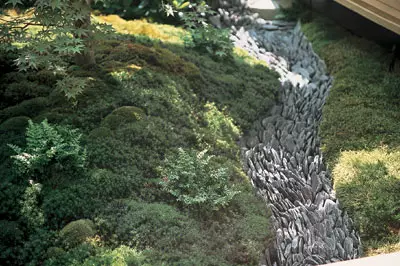
Imitation of the stream catering among the moss. The MAY MAYS is usually replaced by solids and encounter creaming of the "dry" gardens, very painstaking. The pebble platform is first treated with roundap several times, then tamper, leveled and laid on top of Lutracil (thick nonwoven material transmitting water, while preventing weed growth) or Agril, spunbond. Then set stones and stone groups and only after that they fall asleep pebbles. It is very relevant to her cleaning from fallen leaves, flowers from trees, earrings, pollen. If the maple leaves are removed manually easy, then next to the birch "dry" or simply sites from pebbles is better not to create - the troubles are not wrapped. It is difficult to maintain a pattern on pebbles. In the intense summer, he keeps around a week or two, then it is flown. By the way, all the stones in the Japanese garden are "growing" from the ground, and do not lie on her surface.
Bamboo products, as well as lanterns and pagodas made of natural, artificial stone or plastic, can be purchased on many garden markets. Plastic lamps are impractical, they are easy to carry the wind, the stone are very expensive (from $ 600-800 to $ 2,000 or more). Lanterns and fagodes made of artificial stone produce Agaba (Germany), Kors, Sparks Group (Russia) and other firms (cost - from $ 200-300).
The editors thanks the main landscape architect of the GBS RAS Elena votel, the landscape architect Alexander Sapelin, as well as the information department of the Japanese Embassy in Moscow for help in preparing the material.
